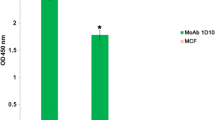Abstract
In this study, it was confirmed whether the galactose-binding protein (GBP) was present in Acanthamoeba castellanii, and its function on a target cell was confirmed by production of an antibody against the GBP. Since the genes for GBP have not yet been identified at all, the purification of GBP was done using galactose-beads from amoebial lysates, and monoclonal antibodies were produced using cell fusion. GBP was confirmed to have a size of about 35 kDa. After the third immunization with purified GBP in BALB/c mice, monoclonal antibody production was analyzed. The clone cultured before limiting dilution was named 2AB2 and showed the highest antibody titer in the culture supernatant of a 24-well plate. AF6 clone cultured after limiting dilution showed an antibody titer of 0.259 in a 75-T flask. Antibodies generated by collecting ascites by injecting monoclonal colonies into the abdominal cavity of mice were confirmed through gel analysis and were observed to belong to the isotype of the IgM having kappa chains. Since the cytotoxicity of A. castellanii was inhibited by about 26% by the monoclonal antibody against GBP, it was confirmed that the antibody against GBP had an inhibitory effect on cytotoxicity. This study was the first report on GBP isolated and purified from A. castellanii, and similarly to a mannose-binding protein (MBP), its involvement in contact-dependent cytotoxicity was demonstrated with monoclonal antibody production.




Similar content being viewed by others
References
Cao Z, Jefferson DM, Panjwani N (1998) Role of carbohydrate-mediated adherence in cytopathogenic mechanisms of Acanthamoeba. J Biol Chem 273(25):15838–15845
Chen XM, LaRusso NF (2000) Mechanisms of attachment and internalization of Cryptosporidium parvum to biliary and intestinal epithelial cells. Gastroenterol 118(2):368–379
Garate M, Cao Z, Bateman E, Panjwani N (2004) Cloning and characterization of a novel mannose-binding protein of Acanthamoeba. J Biol Chem 279(28):29849–29905
Garate M, Marchant J, Cubillos I, Cao Z, Khan NA, Panjwani N (2006) In vitro pathogenicity of Acanthamoeba is associated with the expression of the mannose-binding protein. Invest Ophthal Vis Sci 47(3):1056–1062
Jeong SR, Lee SC, Song KJ, Park S, Kim K, Kwon MH, Im KI, Shin HJ (2005) Expression of the nfa1 gene cloned from pathogenic Naegleria fowleri in nonpathogenic N. gruberi enhances cytotoxicity against CHO target cells in vitro. Infect Immun 73(7):4098–4105
Jung SY, Matin A, Kim KS, Khan NA (2007) The capsule plays an important role in Escherichia coli K1 interactions with Acanthamoeba. Int J Parasitol 37(3–4):417–423
Kang AY, Park AY, Shin HJ, Khan NA, Maciver S, Jung SY (2018) Production of a monoclonal antibody against a mannose-binding protein of Acanthamoeba culbertsoni and its localization. Exp Parasitol 192:19–24
Kato K, Yahata K, Dhoubhadel BG, Fujii Y, Tachibana H (2015) Novel hemagglutinating, hemolytic and cytotoxic activities of the intermediate subunit of Entamoeba histolytica lectin. Sci Rep 5:13901
Khan NA (2006) Acanthamoeba: biology and increasing importance in human health. FEMS Microbiol Rev 30(4):564–595
Kim JH, Matin A, Shin HJ, Park H, Yoo KT, Yuan XZ, Kim KS, Jung SY (2012) Functional roles of mannose-binding protein in the adhesion, cytotoxicity and phagocytosis of Acanthamoeba castellanii. Exp Parasitol 132(2):287–292
Kitzmann AS, Goins KM, Sutphin JE, Wagoner MD (2009) Keratoplasty for treatment of Acanthamoeba keratitis. Ophthalmol 116(5):864–869
Laemmli UK (1970) Cleavage of structural proteins during the assembly of the head of bacteriophage T4. Nature 227(5259):680–685
Matin A, Siddiqui R, Jung SY, Kim KS, Stins M, Khan NA (2007) Balamuthia mandrillaris interactions with human brain microvascular endothelial cells in vitro. J Med Microbiol 56(Pt 8):1110–1115
Park AY, Kang AY, Jung SY (2018) Protective effects of a monoclonal antibody to a mannose-binding protein of Acanthamoeba culbertsoni. Biomed Sci Lett 24(4):435–438
Ruqaiyyah S, Khan NA (2012) Biology and pathogenesis of Acanthamoeba. Parasites Vectors 5(6):1–13
Saouros S, Edwards-Jones B, Reiss M, Sawmynaden K, Cota E, Simpson P, Dowse TJ, Jäkle U, Ramboarina S, Shivarattan T, Matthews S, Soldati-Favre D (2005) A novel galectin-like domain from Toxoplasma gondii micronemal protein 1 assists the folding, assembly, and transport of a cell adhesion complex. J Biol Chem 280(46):38583–38591
Seong GS, Sohn HJ, Kang H, Seo GE, Kim JH, Shin HJ (2017) Production and characterization of monoclonal antibodies against cathepsin B and cathepsin B-Like proteins of Naegleria fowleri. Exp Parasitol 183:171–177
Silber AM, Marcipar IS, Roodveldt C, Cabeza Meckert P, Laguens R, Marcipar AJ. Trypanosoma cruzi: identification of a galactose-binding protein that binds to cell surface of human erythrocytes and is involved in cell invasion by the parasite. Exp Parasitol 100 4 217 225
Singh RS, Walia AK, Kanwar JR (2016) Protozoa lectins and their role in host-pathogen interactions. Biotechnol Adv 34(5):1018–1029
Funding
This research was supported by Basic Science Research Program through the National Research Foundation of Korea (NRF) funded by the Ministry of Education (2017R1D1A1A02018651).
Author information
Authors and Affiliations
Corresponding author
Ethics declarations
Conflict of interest
The authors declare no competing interests.
Additional information
Section Editor: Sutherland Maciver
Publisher's note
Springer Nature remains neutral with regard to jurisdictional claims in published maps and institutional affiliations.
Rights and permissions
About this article
Cite this article
Kim, DY., Son, DH., Matin, A. et al. Production of a monoclonal antibody against a galactose-binding protein of Acanthamoeba castellanii and its cytotoxicity. Parasitol Res 120, 3845–3850 (2021). https://doi.org/10.1007/s00436-021-07321-6
Received:
Accepted:
Published:
Issue Date:
DOI: https://doi.org/10.1007/s00436-021-07321-6




